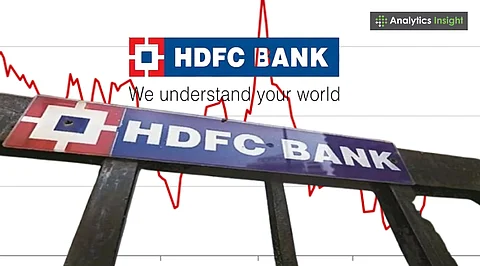

HDFC Bank’s stock is currently trading at ₹2023.70, reflecting a minor 0.10% intraday loss despite opening higher at ₹2014.60.
The 52-week high remains ₹2,037.70, suggesting current prices are hovering just below all-time highs, keeping investor interest steady.
Analysts continue to remain bullish with 76% issuing a ‘Buy’ rating, citing strong fundamentals, low volatility (Beta 0.91), and consistent performance.
HDFC Bank share price is trading at ₹2023.70 as of 12 PM on July 30, 2025. It is a marginal dip of 0.10% from the previous close of ₹2025.80. Despite the slight fall, market analysts remain confident in the bank's long-term performance. 76% recommend a 'Buy' and another 20% suggest 'Outperform' rating for the shares.
The stock opened at ₹2014.60 and moved within a tight range during the trading session, hitting a high of ₹2025.00 and a low of ₹2008.00. The intraday movement reflects market hesitation, even as volume stood at 3,489,367 shares, totaling a value of ₹70,624.79 lakhs. The volume-weighted average price (VWAP) was recorded at ₹2016.59, indicating that most trades took place near current price levels.
HDFC Bank share price chart on TradingView shows a loss of 0.11% as of 12.30 PM:
HDFC Bank shares have shown resilience near its all-time high of ₹2037.70, which is also its 52-week high. The current share price of ₹2023.70 remains just shy of this mark, reflecting continued investor confidence. On the downside, the 52-week low is significantly lower at ₹1593.30, suggesting solid upward momentum in the past year.
The upper circuit (UC) and lower circuit (LC) limits for the day are set at ₹2228.30 and ₹1823.30, respectively. These limits provide a broad cushion for volatility, yet the stock has largely remained within a stable band throughout the day.
Also Read: Stock Market Today: Nifty Rises Above 24,850, Sensex Gains 172.31 points Amid Mixed Trading Session
HDFC Bank commands a massive market capitalization of ₹1,553,041 crore, solidifying its position as one of India's largest financial institutions. The stock has a face value of ₹1 and a beta of 0.91, implying relatively low volatility compared to the broader market.
From a valuation standpoint, the trailing twelve-month (TTM) earnings per share (EPS) is ₹91.98, showing a 2.66% year-over-year increase. With a TTM price-to-earnings (PE) ratio of 22.00, the bank is slightly above its sector PE of 20.31 but remains within a reasonable valuation range given its growth trajectory. The stock's price-to-book (P/B) ratio stands at 3.00, and the book value per share is ₹675.07.
Based on classic pivot point analysis, the immediate resistance levels for investors to watch are at ₹2033.27 (R1), ₹2040.73 (R2), and ₹2048.87 (R3). On the support side, ₹2017.67 (S1), ₹2009.53 (S2), and ₹2002.07 (S3) provide downside protection.
Given its strong financials, stable price action, and positive analyst ratings, HDFC Bank remains a stock to watch closely. Investors should monitor volumes and price action closely as the stock consolidates near its all-time highs, potentially gearing up for a breakout in the sessions ahead.
Also Read: Adani Power Share Price Steady at Rs. 590.80 Ahead of Key Board Meet on Stock Split
1. What is the current share price of HDFC Bank?
As of the latest market session, HDFC Bank’s share price stands at ₹2023.70. The stock opened at ₹2014.60 and reached an intraday low of ₹2008.00. Compared to the previous close of ₹2025.80, it has fallen slightly by 0.10%. The price movement shows stability in investor sentiment, especially considering broader market volatility.
2. How has HDFC Bank stock performed in recent sessions?
HDFC Bank has shown a mixed performance recently. The current session shows a minor 0.10% decline, but the stock remains resilient above ₹2000. Over the past month, the bank has benefited from strong earnings reports, a stable interest rate environment, and consistent institutional support. Its 52-week high of ₹2037.70 remains within reach. Many are interpreting the recent price movement as a healthy consolidation phase rather than a trend reversal.
3. Is HDFC Bank a good stock to buy now?
Yes, HDFC Bank continues to be favored by most analysts. Of the 41 analysts tracking the stock, 76% have issued a ‘Buy’ rating, while 17% say ‘Hold.’ The bank maintains strong fundamentals, robust NII (Net Interest Income), and a high return on equity. Additionally, recent strategic expansions in retail and rural banking provide long-term growth potential. However, short-term investors may want to watch for a breakout above ₹2040 for momentum entry.
4. What is the 52-week range for HDFC Bank share price?
HDFC Bank’s 52-week price range lies between ₹1593.30 (the lowest) and ₹2037.70 (the highest). This range reflects steady appreciation driven by the bank’s consistent financial results and strong balance sheet. Historically, HDFC Bank has shown a pattern of bouncing off its lower range and testing its upper resistance during strong quarters. The stock’s ability to stay close to its 52-week high suggests that long-term investors continue to see value in its core operations.
5. What key technical indicators should investors watch?
Technical analysis shows that HDFC Bank’s pivot point is at ₹2025.13. If the stock sustains above this level, it may aim for resistance levels at ₹2033.27 and ₹2040.73. On the downside, key support levels are ₹2017.67 and ₹2009.53. A break below these could trigger short-term weakness, while strength above ₹2040 may lead to a fresh rally. The stock’s RSI remains neutral, and MACD shows consolidation.
Join our WhatsApp Channel to get the latest news, exclusives and videos on WhatsApp
_____________
Disclaimer: Analytics Insight does not provide financial advice or guidance on cryptocurrencies and stocks. Also note that the cryptocurrencies mentioned/listed on the website could potentially be scams, i.e. designed to induce you to invest financial resources that may be lost forever and not be recoverable once investments are made. This article is provided for informational purposes and does not constitute investment advice. You are responsible for conducting your own research (DYOR) before making any investments. Read more about the financial risks involved here.
